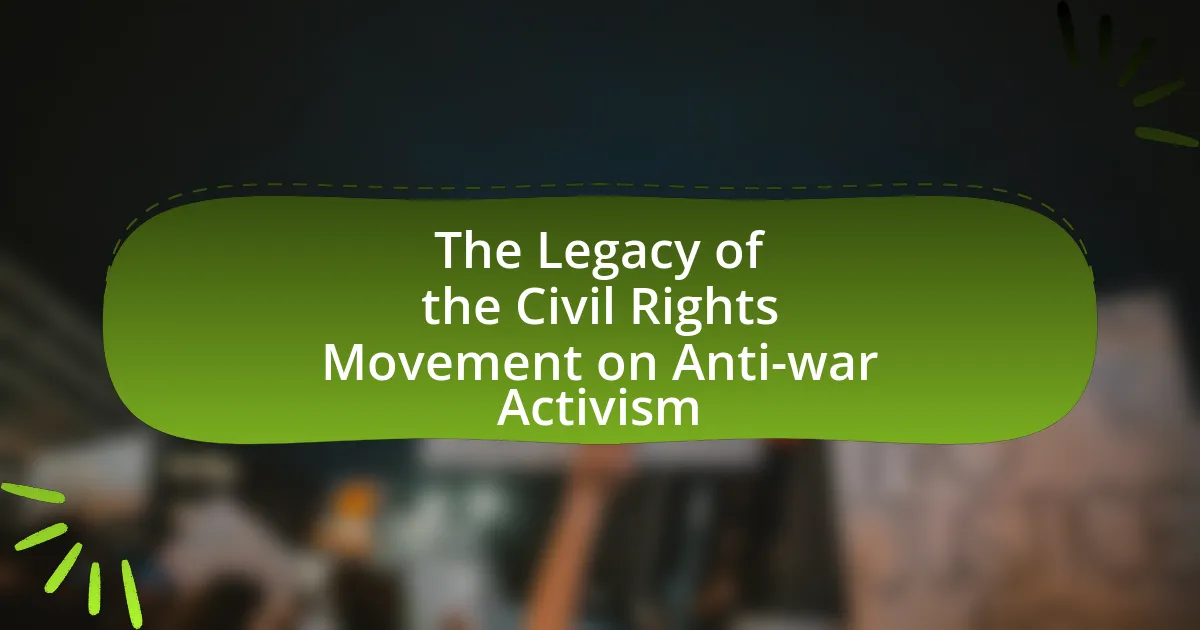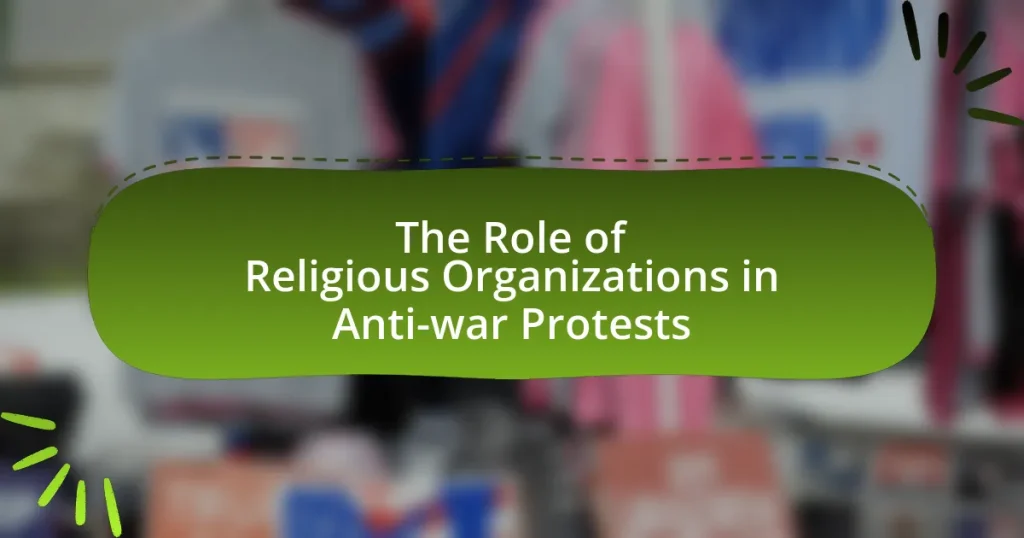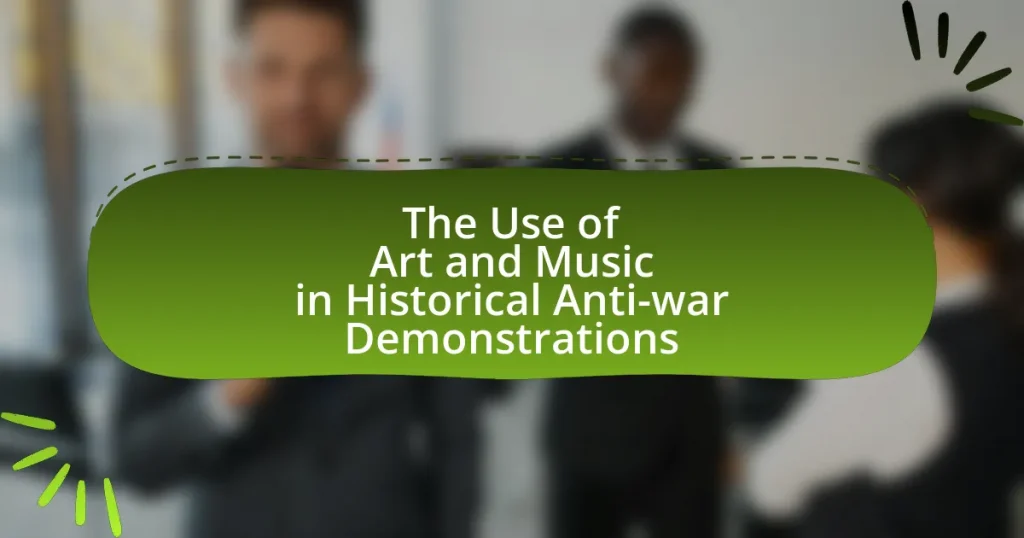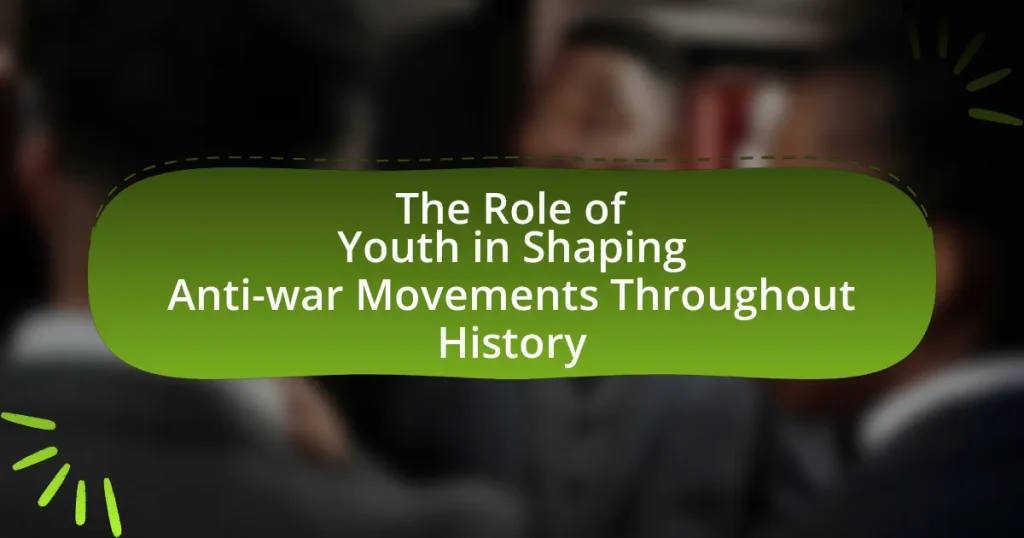The article examines the legacy of the Civil Rights Movement and its profound influence on anti-war activism, particularly during the Vietnam War era. It highlights how leaders like Martin Luther King Jr. connected the struggles for civil rights and peace, emphasizing social justice, equality, and nonviolent protest. Key events, such as the Selma to Montgomery marches and the March on the Pentagon, are discussed to illustrate the intersection of these movements. The article also explores how contemporary anti-war activists draw inspiration from civil rights strategies, the challenges they face today, and the ongoing relevance of these historical connections in current social justice movements.
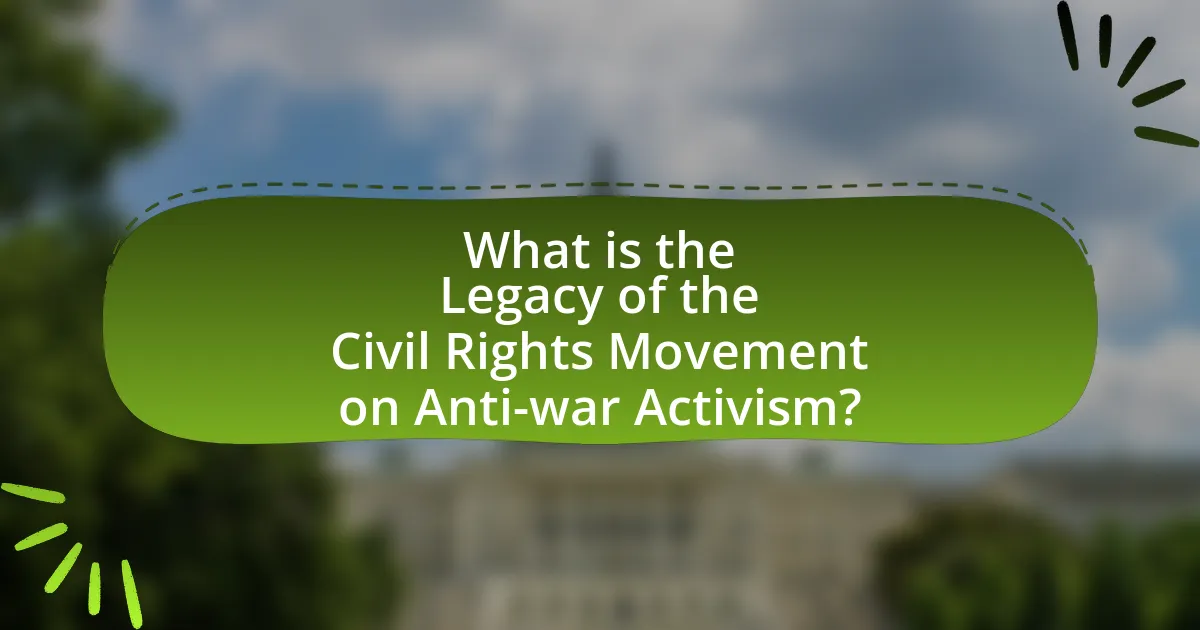
What is the Legacy of the Civil Rights Movement on Anti-war Activism?
The legacy of the Civil Rights Movement significantly influenced anti-war activism by promoting the principles of social justice, equality, and nonviolent protest. Activists like Martin Luther King Jr. drew parallels between the struggle for civil rights and opposition to the Vietnam War, arguing that both were rooted in the fight against oppression and inequality. This connection was exemplified in King’s 1967 speech, “Beyond Vietnam,” where he articulated the moral imperative to oppose war as a means of achieving social justice. The Civil Rights Movement’s emphasis on grassroots organizing and coalition-building also inspired anti-war groups to unite diverse communities in their opposition to military conflict, thereby shaping a broader social movement that linked civil rights with anti-war sentiments.
How did the Civil Rights Movement influence anti-war sentiments?
The Civil Rights Movement significantly influenced anti-war sentiments by highlighting the connections between racial injustice and militarism. Activists, such as Martin Luther King Jr., articulated that the struggle for civil rights was intertwined with opposition to the Vietnam War, arguing that the resources spent on war detracted from addressing poverty and inequality at home. This perspective was reinforced by the fact that African Americans were disproportionately drafted and sent to fight in Vietnam, which fueled resentment and opposition among civil rights advocates. The movement’s emphasis on social justice and equality galvanized a broader anti-war coalition, leading to increased protests and public dissent against U.S. military involvement in Vietnam.
What key events linked the Civil Rights Movement and anti-war activism?
Key events that linked the Civil Rights Movement and anti-war activism include the 1965 Selma to Montgomery marches and the 1967 March on the Pentagon. The Selma marches highlighted the struggle for voting rights and racial equality, drawing national attention and support, which paralleled the growing opposition to the Vietnam War. The March on the Pentagon, organized by anti-war activists, included prominent Civil Rights leaders like Martin Luther King Jr., emphasizing the interconnectedness of social justice and peace movements. These events demonstrated how the fight against racial injustice and the opposition to the Vietnam War were seen as part of a broader struggle for human rights and equality.
How did leaders from the Civil Rights Movement participate in anti-war protests?
Leaders from the Civil Rights Movement actively participated in anti-war protests by linking the struggle for racial equality to opposition against the Vietnam War. Prominent figures such as Martin Luther King Jr. publicly condemned the war, arguing that it diverted resources from social programs aimed at addressing poverty and racial injustice. In 1967, King delivered his famous “Beyond Vietnam” speech, where he articulated the moral imperative to oppose the war, stating that the U.S. was “the greatest purveyor of violence in the world today.” This connection between civil rights and anti-war activism galvanized many activists and highlighted the intersectionality of social justice issues during that era.
Why is the legacy of the Civil Rights Movement significant for modern anti-war activism?
The legacy of the Civil Rights Movement is significant for modern anti-war activism because it established a framework for grassroots organizing, nonviolent protest, and the moral imperative of social justice. The Civil Rights Movement demonstrated how collective action could challenge systemic oppression, inspiring contemporary activists to draw parallels between civil rights and anti-war efforts. For instance, leaders like Martin Luther King Jr. articulated the interconnectedness of social justice and peace, famously stating that “injustice anywhere is a threat to justice everywhere.” This philosophy has influenced modern movements, such as the anti-war protests against the Iraq War, where activists invoked civil rights principles to argue against military intervention and advocate for marginalized communities affected by war. The historical success of the Civil Rights Movement in achieving legislative change, such as the Civil Rights Act of 1964, serves as a powerful example for current anti-war activists seeking to effect change through similar strategies of advocacy and mobilization.
What lessons from the Civil Rights Movement are applicable to current anti-war movements?
The Civil Rights Movement teaches current anti-war movements the importance of grassroots organizing and coalition-building. Grassroots organizing was pivotal in the Civil Rights Movement, as seen in the Montgomery Bus Boycott, where local communities mobilized to challenge systemic injustice. Similarly, current anti-war movements can benefit from building broad coalitions that unite diverse groups, enhancing their collective impact. Additionally, the Civil Rights Movement demonstrated the effectiveness of nonviolent protest, exemplified by Martin Luther King Jr.’s philosophy, which remains relevant today as anti-war activists seek to convey their messages peacefully and effectively. The use of media to amplify voices and narratives, as employed during the Civil Rights Movement, is also crucial for current movements to raise awareness and garner public support.
How has the narrative of the Civil Rights Movement shaped public perception of war?
The narrative of the Civil Rights Movement has significantly shaped public perception of war by framing it as a moral issue intertwined with social justice. Activists like Martin Luther King Jr. articulated the connection between civil rights and anti-war sentiments, particularly during the Vietnam War, arguing that the resources spent on military efforts could be better utilized to address poverty and inequality at home. This perspective was reinforced by the widespread protests against the Vietnam War, where civil rights leaders emphasized that the struggle for racial equality was compromised by military engagement abroad. The alignment of civil rights and anti-war activism led to a broader public understanding that war disproportionately affects marginalized communities, thus fostering a critical view of military interventions and promoting a peace-oriented narrative that persists in contemporary discussions about war.
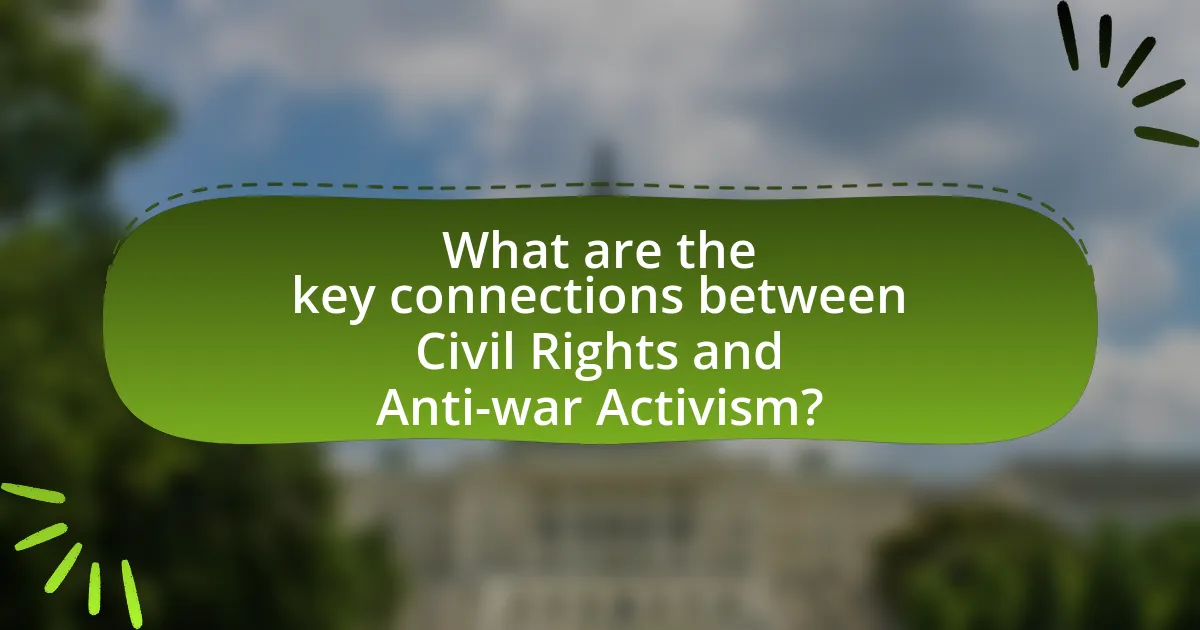
What are the key connections between Civil Rights and Anti-war Activism?
The key connections between Civil Rights and Anti-war Activism lie in their shared goals of social justice and equality, as well as the involvement of prominent leaders and organizations in both movements. Civil Rights activists, such as Martin Luther King Jr., opposed the Vietnam War, arguing that it diverted resources from domestic social programs and disproportionately affected marginalized communities. This intersection is evident in King’s 1967 speech, “Beyond Vietnam,” where he linked the struggle for civil rights with the fight against militarism and economic injustice. Additionally, both movements utilized similar grassroots organizing strategies and nonviolent protest tactics, fostering solidarity among activists who recognized that racial inequality and war were interconnected issues.
How did the ideologies of both movements intersect?
The ideologies of the Civil Rights Movement and anti-war activism intersected primarily through their shared commitment to social justice and equality. Both movements emphasized the importance of human rights, advocating against systemic oppression and discrimination. For instance, leaders like Martin Luther King Jr. articulated a vision that linked the struggle for civil rights with opposition to the Vietnam War, arguing that the war disproportionately affected marginalized communities. This intersection was evident in events such as the 1967 “Beyond Vietnam” speech, where King highlighted the moral imperative to oppose war as part of the broader fight for justice. Thus, the ideologies converged on the principle that true equality cannot exist in a society that perpetuates violence and injustice, reinforcing the notion that civil rights and peace are interconnected goals.
What shared goals did the Civil Rights Movement and anti-war activists pursue?
The Civil Rights Movement and anti-war activists pursued shared goals of social justice, equality, and the promotion of peace. Both movements aimed to challenge systemic oppression and advocate for the rights of marginalized groups. For instance, the Civil Rights Movement sought to end racial segregation and discrimination against African Americans, while anti-war activists opposed the Vietnam War, arguing that it disproportionately affected poor and minority communities. This intersection is evident in the work of leaders like Martin Luther King Jr., who linked civil rights to anti-war sentiments, famously stating that “injustice anywhere is a threat to justice everywhere.”
How did grassroots organizing in both movements influence each other?
Grassroots organizing in the Civil Rights Movement and anti-war activism significantly influenced each other by sharing strategies, mobilizing communities, and fostering a culture of activism. The Civil Rights Movement utilized grassroots tactics such as local organizing, community meetings, and nonviolent protests, which inspired anti-war activists to adopt similar methods for mobilization. For instance, the Student Nonviolent Coordinating Committee (SNCC) not only focused on civil rights but also became involved in anti-war efforts, demonstrating the interconnectedness of these movements. Additionally, both movements emphasized the importance of grassroots leadership, which empowered individuals to take action and advocate for change within their communities. This mutual influence is evident in the way activists from both movements collaborated on campaigns, such as the 1967 March on the Pentagon, which drew participants from civil rights organizations.
What role did prominent figures play in bridging these movements?
Prominent figures played a crucial role in bridging the Civil Rights Movement and anti-war activism by leveraging their platforms to advocate for social justice and peace. Leaders such as Martin Luther King Jr. publicly opposed the Vietnam War, linking the struggle for civil rights to the fight against militarism and poverty, thereby uniting diverse groups under a common cause. For instance, King’s speech at the Riverside Church in 1967 explicitly connected racial injustice to the war, stating that “the war is a symptom of a far deeper malady within the American spirit.” This alignment not only amplified the voices of marginalized communities but also fostered solidarity among activists, demonstrating the interconnectedness of civil rights and anti-war efforts.
Who were the key leaders that advocated for both civil rights and anti-war efforts?
Key leaders who advocated for both civil rights and anti-war efforts include Martin Luther King Jr., Malcolm X, and Bayard Rustin. Martin Luther King Jr. is renowned for his leadership in the civil rights movement and his vocal opposition to the Vietnam War, famously stating that “injustice anywhere is a threat to justice everywhere.” Malcolm X, while primarily known for his civil rights activism, also spoke against U.S. involvement in Vietnam, linking the struggles of African Americans to global anti-colonial movements. Bayard Rustin, a key organizer of the 1963 March on Washington, was also an outspoken critic of the Vietnam War, emphasizing the need for peace and justice. Their combined efforts illustrate the interconnectedness of civil rights and anti-war activism during the 1960s.
What speeches or writings exemplified the connection between the two movements?
The speeches and writings that exemplified the connection between the Civil Rights Movement and anti-war activism include Martin Luther King Jr.’s “Beyond Vietnam: A Time to Break Silence” and the “Port Huron Statement” by the Students for a Democratic Society. In “Beyond Vietnam,” delivered in 1967, King articulated the moral imperative to oppose the Vietnam War, linking it to the struggle for civil rights and social justice, emphasizing that the war disproportionately affected marginalized communities. The “Port Huron Statement,” released in 1962, criticized U.S. foreign policy and called for a more equitable society, reflecting the sentiments of both civil rights and anti-war activists. These documents illustrate the intertwined nature of the two movements, highlighting shared values of justice, equality, and peace.
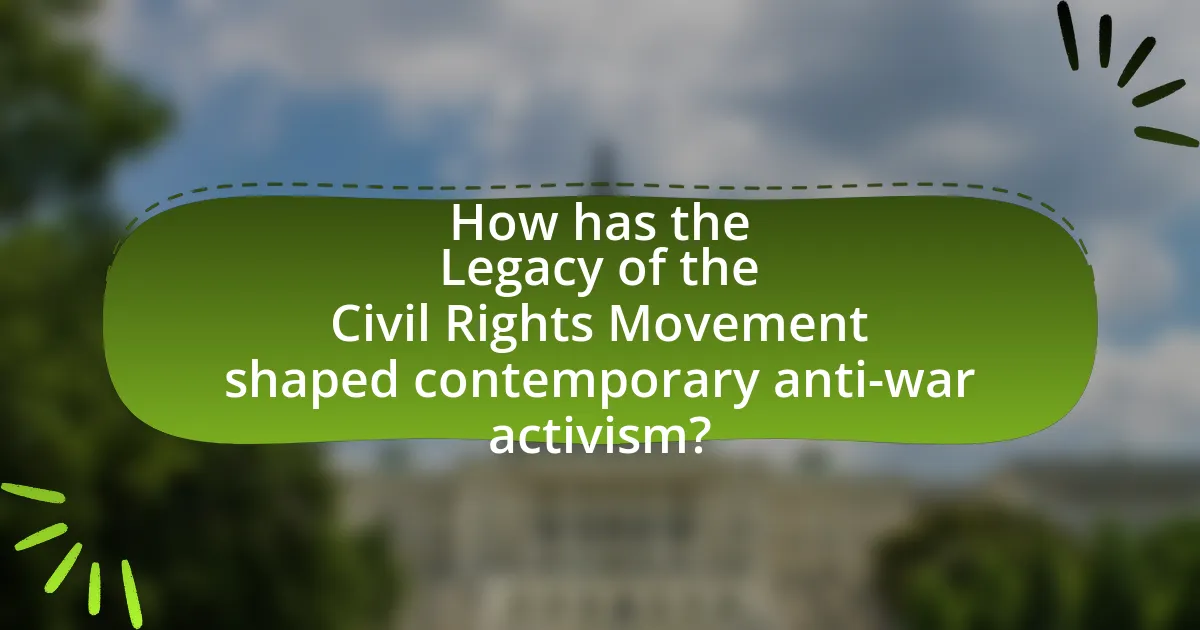
How has the Legacy of the Civil Rights Movement shaped contemporary anti-war activism?
The legacy of the Civil Rights Movement has significantly shaped contemporary anti-war activism by promoting principles of social justice, equality, and nonviolent resistance. Activists today draw inspiration from leaders like Martin Luther King Jr., who articulated the interconnectedness of civil rights and peace, famously stating that “injustice anywhere is a threat to justice everywhere.” This philosophy has led modern anti-war movements to emphasize the moral imperative of opposing war as a means to achieve social justice, particularly in marginalized communities disproportionately affected by military conflict. Furthermore, the Civil Rights Movement’s grassroots organizing strategies and coalition-building efforts have influenced contemporary activists to unite various social justice causes, creating a broader framework for anti-war activism that addresses issues such as poverty, racism, and imperialism.
What current movements reflect the influence of the Civil Rights Movement?
Current movements that reflect the influence of the Civil Rights Movement include Black Lives Matter and the Fight for $15. Black Lives Matter advocates for racial justice and police reform, drawing inspiration from the Civil Rights Movement’s emphasis on equality and nonviolent protest. The Fight for $15 seeks to raise the minimum wage, highlighting economic justice, a key issue during the Civil Rights era, as exemplified by Martin Luther King Jr.’s support for economic rights. Both movements utilize grassroots organizing and social media to mobilize support, echoing the strategies employed during the Civil Rights Movement.
How do modern anti-war activists draw inspiration from civil rights strategies?
Modern anti-war activists draw inspiration from civil rights strategies by employing nonviolent resistance, grassroots organizing, and coalition-building to mobilize public support against war. For instance, the civil rights movement’s emphasis on peaceful protests, such as sit-ins and marches, has influenced contemporary anti-war demonstrations, which often feature similar tactics to raise awareness and challenge government policies. Additionally, the civil rights movement’s focus on inclusivity and intersectionality has encouraged modern activists to address the connections between militarism, social justice, and economic inequality, thereby broadening the anti-war narrative. Historical examples, such as Martin Luther King Jr.’s opposition to the Vietnam War, illustrate how civil rights leaders linked issues of war and peace to the struggle for racial equality, reinforcing the idea that social justice and anti-war activism are interconnected.
What parallels can be drawn between past and present anti-war protests?
Past and present anti-war protests share significant parallels, particularly in their grassroots organization and the use of civil disobedience. Both movements mobilized diverse groups of people united by a common cause, often leveraging social media in contemporary protests to echo the community organizing strategies of the Civil Rights Movement. For instance, the Vietnam War protests of the 1960s saw large-scale demonstrations and sit-ins, similar to the recent protests against the Iraq War, which utilized platforms like Twitter and Facebook to coordinate actions and spread awareness. Additionally, both movements have faced governmental pushback, highlighting the ongoing struggle for free speech and assembly rights. Historical examples include the arrests of activists during the 1960s protests, paralleling the police responses to modern demonstrations, such as those seen in 2020 against military interventions. These similarities underscore a continuous thread of activism rooted in the fight for peace and justice.
What challenges do contemporary activists face in continuing this legacy?
Contemporary activists face significant challenges in continuing the legacy of the Civil Rights Movement on anti-war activism, primarily due to political polarization and the fragmentation of social movements. Political polarization has led to a divided public discourse, making it difficult for activists to unite diverse groups around common goals. Additionally, the fragmentation of social movements results in competing priorities and strategies, which can dilute the effectiveness of collective action. For instance, the rise of digital activism has created both opportunities and challenges, as online platforms can amplify voices but also lead to misinformation and echo chambers that hinder cohesive efforts. These factors complicate the ability of contemporary activists to draw on the historical lessons of the Civil Rights Movement while addressing current anti-war issues effectively.
How do societal attitudes towards war and civil rights intersect today?
Societal attitudes towards war and civil rights intersect today through a shared emphasis on justice, equality, and the moral implications of military actions. Many contemporary anti-war movements draw inspiration from the civil rights movement, highlighting how marginalized communities often bear the brunt of both war and systemic injustice. For instance, the Black Lives Matter movement has linked issues of police violence and military intervention, arguing that both stem from a broader context of racial inequality and oppression. This intersection is evident in protests where activists advocate for peace while simultaneously demanding civil rights, reflecting a holistic approach to social justice that recognizes the interconnectedness of these struggles.
What strategies can activists employ to honor this legacy effectively?
Activists can honor the legacy of the Civil Rights Movement on anti-war activism by employing strategies such as grassroots organizing, coalition-building, and utilizing digital platforms for awareness. Grassroots organizing allows activists to mobilize communities, echoing the Civil Rights Movement’s emphasis on local engagement and collective action. Coalition-building with diverse groups fosters solidarity and amplifies voices, reminiscent of the alliances formed during the Civil Rights era, which were crucial for achieving social change. Additionally, leveraging digital platforms for awareness campaigns can reach wider audiences, similar to how the Civil Rights Movement utilized media to highlight injustices. These strategies are effective as they draw on historical precedents of successful activism, demonstrating the power of community and collaboration in driving social change.
What practical steps can individuals take to engage in anti-war activism today?
Individuals can engage in anti-war activism today by participating in organized protests and rallies that advocate for peace and oppose military interventions. These events often bring together like-minded individuals and amplify collective voices against war. Additionally, individuals can educate themselves and others about the impacts of war through workshops, discussions, and social media campaigns, fostering a more informed community. Supporting and donating to organizations that focus on peacebuilding and conflict resolution, such as the American Friends Service Committee, can also be a practical step. Furthermore, contacting elected representatives to express opposition to military actions and advocating for diplomatic solutions can influence policy decisions. Engaging in local community efforts, such as writing articles or creating art that promotes peace, can further contribute to the anti-war movement.
